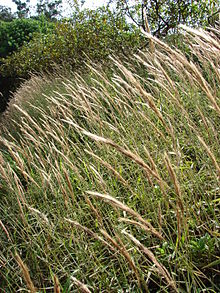- Melinis minutiflora
-
Melinis minutiflora 
Scientific classification Kingdom: Plantae (unranked): Angiosperms (unranked): Monocots (unranked): Commelinids Order: Poales Family: Poaceae Genus: Melinis Species: M. minutiflora Binomial name Melinis minutiflora
P.Beauv.Melinis minutiflora, commonly known as molasses grass, is a species of grass. It has been weedy in Australia, where it has been introduced.
Minutiflora Melinis is a Perennial grass of genus Melinis . It is a native of Africa. It spreads in the form of mat. Presents stems erect up to 1.5 meters high. The leaves are covered with fragrant foliage and sticky, reddish inflorescence. It blooms for short periods. It is believed that the fresh smell ofM. minutiflora repels insects and snakes.
It was introduced in tropical countries for livestock feed, for animal husbandry, and soon was naturalized. However, it is considered a invasive species in many parts of the world, is relevant to Pacific Islands, provided by the Global Compendium of Weeds (GCW), including Hawaii, Brazil, Venezuela, Colombia, and may have contributed to the disappearance of native species in different regions. It has been used, yet as pioneer species in poor soil planting and neutralizes other weeds that may appear.
Exotic grasses are becoming increasingly abundant in Neotropical savannas, with Melinis minutiflora Beauv. being particularly invasive. Tested the effect of this species on the establishment, survival and growth of seedlings of seven tree species native to the savannas and forests of the Cerrado region of Brazil. Seeds of the tree species were sown in 40 study plots, of which 20 were sites dominated by M. minutiflora, and 20 were dominated by native grasses. The exotic grass had no discernable effect on initial seedling emergence, as defined by the number of seedlings present at the end of the first growing season. Subsequent seedling survival in plots dominated by M. minutiflora was less than half that of plots dominated by native species. Consequently, at the end of the third growing season, invaded plots had only 44% as many seedlings as plots with native grasses. Above-ground grass biomass of invaded plots was more than twice that of uninvaded plots, while seedling survival was negatively correlated with grass biomass, suggesting that competition for light may explain the low seedling survival where M. minutiflora is dominant.
Categories:- Poaceae
- Invasive plant species
- Grass stubs
Wikimedia Foundation. 2010.
